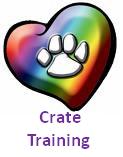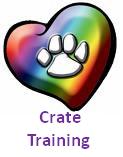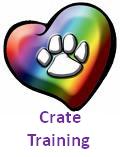
Petfinder recommends that you should always take reasonable security steps before making online payments.
Meet Crate Training
Introduction
Providing your puppy or dog with an indoor kennel crate can satisfy many dogs' need for a den-like enclosure. Besides being an effective housebreaking tool (because it takes advantage of the dog's natural reluctance to soil its sleeping place), it can also help to reduce separation anxiety, to prevent destructive behavior (such as chewing furniture), to keep a puppy away from potentially dangerous household items (i.e., poisons, electrical wires, etc.), and to serve as a mobile indoor dog house which can be moved from room to room whenever necessary.
Most dogs which have been introduced to the kennel crate while still young grow up to prefer their crate to rest in or "hang-out" in. Therefore a crate (or any other area of confinement) should NEVER be used for the purpose of punishment. We recommend that you provide a kennel crate throughout your dog's lifetime. Some crates allow for the removal of the door once it is no longer necessary for the purpose of training. The crate can be placed under a table, or a table top can be put on top of it to make it both unobtrusive and useful.
Preparing the Crate
Vari-Kennel type: Take the crate apart, removing the screws, the top and the door. Allow your pup to go in and out of the bottom half of the crate before attaching the top half. This stage can require anywhere from several hours to a few days. This step can be omitted in the case of a young puppy who accepts crating right away.
Wire Mesh type:Tie the crate door back so that it stays open without moving or shutting closed. If the crate comes with a floor pan, place a piece of cardboard or a towel between the floor (or crate bottom) and the floor pan in order to keep it from rattling.
Furnishing Your Puppy's Crate
Toys and Treats: Place your puppy's favorite toys and dog treats at the far end opposite the door opening. These toys may include the "Tuffy", "Billy", "Kong", "Nylabone" or a ball. Toys and bails should always be inedible and large enough to prevent their being swallowed. Any fragmented toys should be removed to prevent choking and internal obstruction. You may also place a sterilized marrow bone filled with cheese or dog treats in the crate.
Water: A small hamster-type water dispenser with ice water should be attached to the crate if your puppy is to be confined for more than two hours in the crate.
Bedding: Place a towel or blanket inside the crate to create a soft, comfortable bed for the puppy. If the puppy chews the towel, or urinates on it, remove it immediately and don’t place it back in the kennel until that behavior stops. Although most puppies prefer lying on soft bedding, some may prefer to rest on a hard, flat surface, and may push the towel to one end of the crate to avoid it. .
Location of Crate
Whenever possible, place the crate near or next to you when you are home. This will encourage the pup to go inside it without his feeling lonely or isolated when you go out. A central room in the apartment (i.e.: living room or kitchen) or a large hallway near the entrance is a good place to crate your puppy.
Introducing the Crate to Your Puppy
In order that your puppy associate his/her kennel crate with comfort, security and enjoyment, please follow these guidelines:
1. Occasionally throughout the day, drop small pieces of kibble or dog biscuits in the crate. While investigating his new crate, the pup will discover edible treasures thus reinforcing his positive associations with the crate. You may also feed him in the crate to create the same effect. If the dog hesitates, it often works to feed him in front of the crate, then right inside the doorway and then, finally, in the back of the crate.
2. In the beginning, praise and pet your pup when he enters. Do not try to push, pull or force the puppy into the crate. At this early stage of introduction only inducive methods are suggested. Overnight exception: You may need to place your pup in his crate and shut the door upon retiring. (In most cases, the crate should be placed next to your bed overnight. If this is not possible, the crate can be placed in the kitchen, bathroom or living room.)
3. You may also play this enjoyable and educational game with your pup or dog: without alerting your puppy, drop a small dog biscuit into the crate. Then call your puppy and say to him, "Where's the biscuit? It's in your room." Using only a friendly, encouraging voice, direct your pup toward his crate. When the puppy discovers the treat, give enthusiastic praise. The biscuit will automatically serve as a primary reward. Your pup should be free to leave its crate at all times during this game. Later on, your puppy's toy or ball can be substituted for the treat.
**It is advisable first to crate your pup for short periods of time while you are home with him. In fact, crate training is best accomplished while you are in the room with your dog. Getting him used to your absence from the room in which he is crated is a good first step. This prevents an association being made with the crate and your leaving him/her alone.
A Note About Crating Puppies
Puppies under 4 months of age have little bladder or sphincter control. Puppies under 3 months have even less. Very young puppies under 9 weeks should not be crated, as they need to eliminate very frequently (usually 8-12 times or more daily). Be sure to remove all collars before placing your pet in the crate, even flat collars can get caught and result in loss of a pet due to them hanging themselves when alone.
Accidents In The Crate
If your puppy messes in his crate while you are out, do not punish him upon your return. Simply wash out the crate using a pet odor neutralizer (such as Nature's Miracle, Nilodor, or Outright). Do not use ammonia-based products, as their odor resembles urine and may draw your dog back to urinate in the same spot again.
The Crate As Punishment
NEVER use the crate as a form of punishment or reprimand for your puppy or dog. This simply causes the dog to fear and resent the crate. If correctly introduced to his crate, your puppy should be happy to go into his crate at any time. You may however use the crate as a brief time-out for your puppy as a way of discouraging nipping or excessive rowdiness. Do not allow children to play in your dog’s crate or to handle your dog while he/she is in the crate. The crate is your dog’s private sanctuary and his/her rights to privacy should be respected.
Barking In The Crate
In most cases a pup who cries incessantly in his crate has either been crated too soon (without taking the proper steps as outlined above) or is suffering from separation anxiety and is anxious about being left alone. Placing a blanket over the crate can help by reducing distractions and eventually allows the pet to sleep. Some breeds of dogs, however, may be particularly vocal (e.g., Miniature Pinchers, Mini Schnauzers, and other frisky terrier types). Ultimately, never run to the crate in the beginning if you hear barking because this will lead to repeat behavior since the pet will know how to “train” you to let s/he out.
Buying a Crate
Crates can be purchased through most pet supply outlets, through pet mail order catalogs and many variety stores. When choosing a size, it is best to purchase a crate that will allow the dog/puppy to lay down and comfortably turn around in. If purchasing a crate that can be used for puppy and adulthood, it may be necessary to block off a portion of the crate for the puppy so they don’t compartmentalize it into a bathroom, bedroom, etc. Cost of crates can vary depending on style/design normally ranging $35-$150.
The Cost of Not Buying a Crate –chewed shoes, table legs, chairs/sofas, carpets/rugs, electrical/computer/telephone cords, scratched doors/walls, etc.The real cost, however, is your dog's safety and your peace of mind.
Robin Kovary (1999)
Information obtained at http://www.inch.com/~dogs/cratetraining.html
Providing your puppy or dog with an indoor kennel crate can satisfy many dogs' need for a den-like enclosure. Besides being an effective housebreaking tool (because it takes advantage of the dog's natural reluctance to soil its sleeping place), it can also help to reduce separation anxiety, to prevent destructive behavior (such as chewing furniture), to keep a puppy away from potentially dangerous household items (i.e., poisons, electrical wires, etc.), and to serve as a mobile indoor dog house which can be moved from room to room whenever necessary.
Most dogs which have been introduced to the kennel crate while still young grow up to prefer their crate to rest in or "hang-out" in. Therefore a crate (or any other area of confinement) should NEVER be used for the purpose of punishment. We recommend that you provide a kennel crate throughout your dog's lifetime. Some crates allow for the removal of the door once it is no longer necessary for the purpose of training. The crate can be placed under a table, or a table top can be put on top of it to make it both unobtrusive and useful.
Preparing the Crate
Vari-Kennel type: Take the crate apart, removing the screws, the top and the door. Allow your pup to go in and out of the bottom half of the crate before attaching the top half. This stage can require anywhere from several hours to a few days. This step can be omitted in the case of a young puppy who accepts crating right away.
Wire Mesh type:Tie the crate door back so that it stays open without moving or shutting closed. If the crate comes with a floor pan, place a piece of cardboard or a towel between the floor (or crate bottom) and the floor pan in order to keep it from rattling.
Furnishing Your Puppy's Crate
Toys and Treats: Place your puppy's favorite toys and dog treats at the far end opposite the door opening. These toys may include the "Tuffy", "Billy", "Kong", "Nylabone" or a ball. Toys and bails should always be inedible and large enough to prevent their being swallowed. Any fragmented toys should be removed to prevent choking and internal obstruction. You may also place a sterilized marrow bone filled with cheese or dog treats in the crate.
Water: A small hamster-type water dispenser with ice water should be attached to the crate if your puppy is to be confined for more than two hours in the crate.
Bedding: Place a towel or blanket inside the crate to create a soft, comfortable bed for the puppy. If the puppy chews the towel, or urinates on it, remove it immediately and don’t place it back in the kennel until that behavior stops. Although most puppies prefer lying on soft bedding, some may prefer to rest on a hard, flat surface, and may push the towel to one end of the crate to avoid it. .
Location of Crate
Whenever possible, place the crate near or next to you when you are home. This will encourage the pup to go inside it without his feeling lonely or isolated when you go out. A central room in the apartment (i.e.: living room or kitchen) or a large hallway near the entrance is a good place to crate your puppy.
Introducing the Crate to Your Puppy
In order that your puppy associate his/her kennel crate with comfort, security and enjoyment, please follow these guidelines:
1. Occasionally throughout the day, drop small pieces of kibble or dog biscuits in the crate. While investigating his new crate, the pup will discover edible treasures thus reinforcing his positive associations with the crate. You may also feed him in the crate to create the same effect. If the dog hesitates, it often works to feed him in front of the crate, then right inside the doorway and then, finally, in the back of the crate.
2. In the beginning, praise and pet your pup when he enters. Do not try to push, pull or force the puppy into the crate. At this early stage of introduction only inducive methods are suggested. Overnight exception: You may need to place your pup in his crate and shut the door upon retiring. (In most cases, the crate should be placed next to your bed overnight. If this is not possible, the crate can be placed in the kitchen, bathroom or living room.)
3. You may also play this enjoyable and educational game with your pup or dog: without alerting your puppy, drop a small dog biscuit into the crate. Then call your puppy and say to him, "Where's the biscuit? It's in your room." Using only a friendly, encouraging voice, direct your pup toward his crate. When the puppy discovers the treat, give enthusiastic praise. The biscuit will automatically serve as a primary reward. Your pup should be free to leave its crate at all times during this game. Later on, your puppy's toy or ball can be substituted for the treat.
**It is advisable first to crate your pup for short periods of time while you are home with him. In fact, crate training is best accomplished while you are in the room with your dog. Getting him used to your absence from the room in which he is crated is a good first step. This prevents an association being made with the crate and your leaving him/her alone.
A Note About Crating Puppies
Puppies under 4 months of age have little bladder or sphincter control. Puppies under 3 months have even less. Very young puppies under 9 weeks should not be crated, as they need to eliminate very frequently (usually 8-12 times or more daily). Be sure to remove all collars before placing your pet in the crate, even flat collars can get caught and result in loss of a pet due to them hanging themselves when alone.
Accidents In The Crate
If your puppy messes in his crate while you are out, do not punish him upon your return. Simply wash out the crate using a pet odor neutralizer (such as Nature's Miracle, Nilodor, or Outright). Do not use ammonia-based products, as their odor resembles urine and may draw your dog back to urinate in the same spot again.
The Crate As Punishment
NEVER use the crate as a form of punishment or reprimand for your puppy or dog. This simply causes the dog to fear and resent the crate. If correctly introduced to his crate, your puppy should be happy to go into his crate at any time. You may however use the crate as a brief time-out for your puppy as a way of discouraging nipping or excessive rowdiness. Do not allow children to play in your dog’s crate or to handle your dog while he/she is in the crate. The crate is your dog’s private sanctuary and his/her rights to privacy should be respected.
Barking In The Crate
In most cases a pup who cries incessantly in his crate has either been crated too soon (without taking the proper steps as outlined above) or is suffering from separation anxiety and is anxious about being left alone. Placing a blanket over the crate can help by reducing distractions and eventually allows the pet to sleep. Some breeds of dogs, however, may be particularly vocal (e.g., Miniature Pinchers, Mini Schnauzers, and other frisky terrier types). Ultimately, never run to the crate in the beginning if you hear barking because this will lead to repeat behavior since the pet will know how to “train” you to let s/he out.
Buying a Crate
Crates can be purchased through most pet supply outlets, through pet mail order catalogs and many variety stores. When choosing a size, it is best to purchase a crate that will allow the dog/puppy to lay down and comfortably turn around in. If purchasing a crate that can be used for puppy and adulthood, it may be necessary to block off a portion of the crate for the puppy so they don’t compartmentalize it into a bathroom, bedroom, etc. Cost of crates can vary depending on style/design normally ranging $35-$150.
The Cost of Not Buying a Crate –chewed shoes, table legs, chairs/sofas, carpets/rugs, electrical/computer/telephone cords, scratched doors/walls, etc.The real cost, however, is your dog's safety and your peace of mind.
Robin Kovary (1999)
Information obtained at http://www.inch.com/~dogs/cratetraining.html
Recommended Content
Recommended Pets
Finding pets for you…
Recommended Pets
Finding pets for you…

Crate Training
- Affenpinscher
- Puppy
- Female
